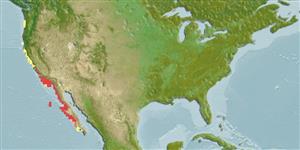Common names from other countries
>
Perciformes/Serranoidei (Groupers) >
Serranidae (Sea basses: groupers and fairy basslets)
Etymology: Paralabrax: Greek, para = the side of + Greek, labrax, -akos = a fish, Dicentrarchus labrax (Ref. 45335).
More on author: Girard.
Environment: milieu / climate zone / depth range / distribution range
Ecologia
marinhas bentopelágico; intervalo de profundidade 1 - 61 m (Ref. 96339), usually 3 - 25 m (Ref. 32351). Subtropical; 48°N - 23°N, 126°W - 109°W
Eastern Pacific: Columbia River in Washington, USA to southern Baja California, Mexico.
Tamanho / Peso / Idade
Maturity: Lm ? range ? - ? cm
Max length : 72.0 cm TL macho/indeterminado; (Ref. 2850); peso máx. Publicado: 7.0 kg (Ref. 9342); Idade máx. registada: 34 anos (Ref. 56049)
Usually found in or near kelp beds, shallow water and to about 50 m but mostly from 2.4-21m . Found throughout water column. Large specimens usually occur in deeper water. Juveniles feed on benthic invertebrates (especially crustaceans); adults feed on fishes and cephalopods (Ref.9342). Both juveniles and adults may feed on plankton when abundant (Ref.9342). Pelagic spawners (Ref. 56049). Also caught with troll lines (Ref. 9342). Excellent food fish and an important game fish (Ref. 9342).
Pelagic spawner (Ref. 56049). Spawning aggregations are a significant component of the reproductive behavior of this species (Ref. 59326). Also Ref. 103751.
Eschmeyer, W.N., E.S. Herald and H. Hammann, 1983. A field guide to Pacific coast fishes of North America. Boston (MA, USA): Houghton Mifflin Company. xii+336 p. (Ref. 2850)
Categoria na Lista Vermelha da IUCN (Ref. 130435)
Warning: mysqli::__construct(): (08004/1040): Too many connections in /var/www/html/includes/func_getlabel.php on line 46
Can't connect to MySQL database (fbapp). Errorcode: Too many connections
